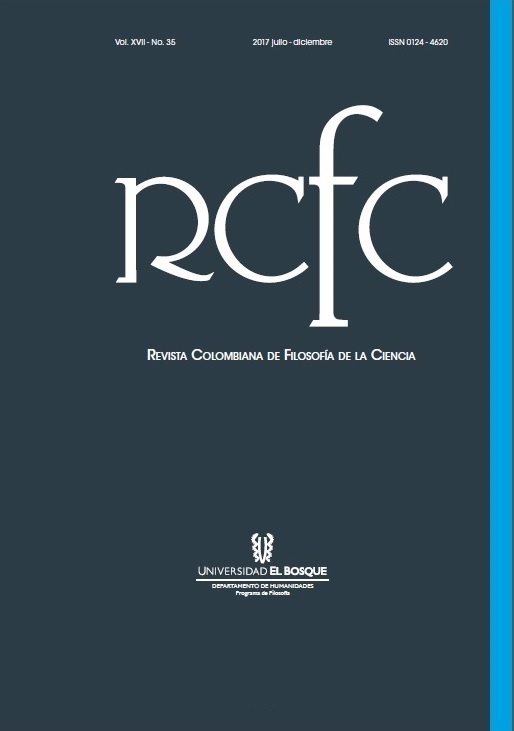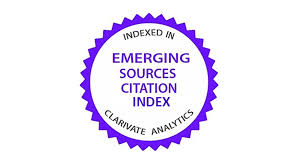Representar e intervenir el comportamiento humano en la era de la tecnobiología
un aporte desde la filosofía de la biología
DOI:
https://doi.org/10.18270/rcfc.v17i35.2064Palabras clave:
Tecnociencia, Epistemología, Biología del ComportamientoResumen
En la era de la tecnobiología, los saberes de la biología frecuentemente se presentan al público general como una vía segura y eficiente para modificar comportamientos humanos patológicos o indeseables mediante medios tecnológicos. Esta concepción se expresa con especial intensidad en el ámbito de la biomedicina y en el marco del human enhancement. Pero los modos en que las intervenciones tecnológicas allí propuestas se combinan con las representaciones de la biología del comportamiento no ha sido cuidadosamente abordado hasta el momento. En este contexto, en el presente trabajo se explicitan los presupuestos de las intervenciones tecnológicas propuestas en la biomedicina y el human enhancement y se los analiza en el marco de las representaciones de diversos programas de investigación de la biología del comportamiento. La hipótesis general es que las intervenciones sugeridas implican sesgos, omisiones, simplificaciones y equívocos cuando son contrastadas con el conocimiento de la biología del comportamiento. Mientras la mayoría de los estudios filosóficos en tecnociencia se centran en aspectos praxiológicos y axiológicos, aquí se ofrece un abordaje ontológico y epistemológico, diferente pero complementario.
Descargas
Referencias bibliográficas
Abrahamsen, Adele y Bechtel, William. “From Reactive to Endogenously Active Dynamical Conceptions of the Brain”. Philosophy of Behavioral Biology. Boston Studies in Philosophy of Science. Eds.: Plaisance K.S y Reydon T.A.C. Dordrecht: Springer, 2012. 329-366.
Bateson, Patrick y Laland, Kevin. “Tinbergen’s four questions: an appreciation and an update”. Trends in Ecology & Evolution 28.12 (2013): 712-718.
Bensaude-Vincent, Bernadette; Loeve, Sacha; Nordmann, Alfred y Schwarz, Astrid. “Matters of interest: The objects of research in science and technoscience”. Journal for General Philosophy of Science 42 (2011): 365-383.
Boon, Mieke. “Instruments in Science and Technology”. A Companion to the Philosophy of Technology. Eds.: Olsen, J. K. B; Pedersen, S. A. y Hendricks V. F. West Sussex: John Wiley & Sons Ltd, 2009. 78-83.
Buckholtz, Joshua y Meyer-Lindenberg, Andreas. “MAOA and the neurogenetic architecture of human aggression”. Trends in Neuroscience 31 (2008): 120–129.
Caspi, Avshalom; Hariri, Ahmad; Holmes, Andrew et al. ”Genetic sensitivity to the environment: The case of the serotonin transporter gene and its implications for studying complex diseases and traits”. American Journal of Psychiatry 167 (2010): 509 –527.
Clarke, Adele. “Biomedicalization”. The Wiley Blackwell Encyclopedia of Health, Illness, Behavior, and Society (2014): 137–142.
Clarke, Adele; Shim, Janet; Mamo, Laura et al. “Biomedicalization: Technoscientific Transformations of Health, Illness, and U.S. Biomedicine”. American Sociological Review 68.2 (2003): 161-194.
Collins, Francis. The language of life. DNA and the Revolution in Personalized Medicine. Harper: New York, 2010.
Craver, Carl. Explaining the brain. Mechanisms and the mosaic unity of neuroscience. Oxford: Oxford University Press, 2007.
da Fonseca, Flavio.; Ribeiro, Daniel; Carvalho, Nara et al. “Human Transgenesis: Definitions, Technical Possibilities and Moral Challenges”. Philosophy and Technology 25.4 (2012): 513–524.
Douglas, Thomas. “Moral Enhancement”. Enhancing human capacities. Eds.: Savulescu, J; ter Meulen, R y Kahane, G. West Sussex: John Wiley & Sons Ltd, 2011. 467-485.
Echeverría, Javier. La revolución tecnocientífica. Madrid: Fondo de Cultura Económica, 2003.
Griffiths, Paul y Tabery, James. “Developmental systems theory: What does it explain, and how does it explain it?”. Advances in Child Development and Behavior 44 (2013): 65–94.
Hacking, Ian. Representing and intervening. Cambridge: Cambridge University Press, 1983.
Ihde, Don. “Technology and science”. A Companion to the Philosophy of Technology. Eds.: Olsen, J. K. B; Pedersen, S. A. y Hendricks V. F. West Sussex: John Wiley & Sons Ltd, 2009. 48-60.
Kahane, Guy; Savulescu, Julian y ter Meulen, Ruud. “Preface”. Enhancing human capacities. Eds.: Savulescu, J; ter Meulen, R y Kahane, G. West Sussex: John Wiley & Sons Ltd, 2011. xv-xviii.
Kaiser, Marie. Reductive Explanation in the Biological Sciences. Dordrecht: Springer, 2015.
Kandel, Erick; Schwartz, James; Jessell, Thomas et al. Principles of Neural Science. Nueva York: Mc Graw Hill, 2013.
Lerner, Rrichard. “Complexity Embraced and Complexity Reduced: A Tale of Two Approaches to Human Development”. Human Development 59 (2016): 242–249.
Linares, Jorge. Ética y mundo tecnológico. México: Fondo de Cultura Económica, 2008.
Longino, Helen. “Knowledge for What? Monist, Pluralist, Pragmatist Approaches to the Sciences of Behavior”. Philosophy of Behavioral Biology. Boston Studies in Philosophy of Science. Eds.: Plaisance K.S y Reydon T.A.C. Dordrecht: Springer, 2012. 25-40.
Love, Alan. “From philosophy to science (to natural philosophy): Evolutionary developmental perspectives”. The Quarterly Review of Biology 83.1 (2008): 65–76.
Luo, Liqun. Principles of Neurobiology. New York: Garland Science, 2016.
Maher, Brendan. “Personal genomes: The case of the missing heritability”. Nature 456 (2008): 18–21.
Matthies, Swantje; Rusch, Nicolas; Weber, Matthias; et al. “Small amygdala-high aggression? The role of the amygdala in modulating aggression in healthy subjects”. World Journal of Biological Psychiatry 13.1 (2012): 75–81.
Mayr, Ernst. “Cause and effect in biology”. Science 134 (1961): 1501–1506.
Miczek, Klaus; de Almeida, Rosa; Kravitz, Edward et al. “Neurobiology of escalated aggression and violence”. Journal of Neuroscience 27 (2007): 11803-11806.
Mitchell, Sandra. Unsimple truths. Science, complexity, and policy. Chicago: University of Chicago Press, 2009.
Pardini, Dustin; Raine, Adrian; Erickson, Kirk y Loeber, Rolf. “Lower amygdala volume in men is associated with childhood aggression, early psychopathic traits, and future violence”. Biological Psychiatry 75.1 (2012): 73–80.
Persson, Ingmar y Savulescu, Julian. “The Perils of Cognitive Enhancement and the Urgent Imperative to Enhance the Moral Character of Humanity”. Journal of Applied Philosophy 25.3 (2008): 162-177.
_____. “Getting moral enhancement right: The desirability of moral bioenhancement”. Bioethics 27.3 (2013): 124-131.
Plomin, Robert; DeFries, John; Craig, Ian y McGuffin, Peter. Behavioral Genetics in the Postgenomic Era. Washington D.C.: American Psychological Association, 2002.
Plomin, Robert; DeFries, John; Knopik, Valerie y Neiderheiser, Jenae. Behavioral Genetics. Nueva York: Worth Publishers, 2013.
Purves, Dale. Neuroscience. Massachussets: Sinauer, 2008.
Raeff, Catherine. Exploring the dynamics of human development: An integrative approach. New York: Oxford University Press, 2016.
Rosell Daniel y Siever Larry. “The neurobiology of aggression and violence”. CNS Spectrums 20 (2015): 254-279.
Savulescu, Julian; Sandberg, Anders y Kahane, Guy. “Well-Being and Enhancement”. Enhancing human capacities. Eds.: Savulescu, J; ter Meulen, R y Kahane, G. West Sussex: John Wiley & Sons Ltd, 2011. 3-18.
Shook, John. “Neuroethics and the possible types of moral enhancement”. AJOB Neuroscience 3.4 (2012): 3-14.
Siegel, Allan y Victoroff, Jeff. “Understanding human aggression: new insights from neuroscience”. International Journal of Law and Psychiatry 32.4 (2009): 209–215.
Siever, Larry. “Neurobiology of Agression and Violence”. The American Journal of Psychiatry 165.4 (2008): 429-442.
Silberstein, Michael y Chemero, Anthony. “Constraints on localization and decomposition as explanatory strategies in the biological sciences”. Philosophy of Science 80.5 (2013): 958–70.
Sporns, Olaf. “The human connectome: a complex network”. Annals of the New York Academy of Sciences 1224 (2011): 109–125.
Stetler, Dean; Davis, Chad; Leavitt, Kathryn et al. “Association of low-activity MAOA allelic variants with violent crime in incarcerated offenders”. Journal of Psychiatry Research 58 (2014): 69–75.
Stotz, Karola y Allen, Collins. “From Cell-Surface Receptors to Higher Learning: A Whole World of Experience”. Philosophy of Behavioral Biology. Boston Studies in Philosophy of Science. Eds.: Plaisance K.S y Reydon T.A.C. Dordrecht: Springer, 2012. 85-123.
Tabery, James. Beyond Versus: The Struggle to Understand the Interaction of Nature and Nurture. Cambridge: The MIT Press, 2014.
Tinbergen, Niko. “On aims and methods of ethology”. Zeitschrift für Tierpsychologie 20 (1963): 410- 433.
Turkheimer, Erick. “Genome Wide Association Studies of Behavior are Social Science”. Philosophy of Behavioral Biology. Boston Studies in Philosophy of Science. Eds.: Plaisance K.S y Reydon T.A.C. Dordrecht: Springer, 2012. 43-64.
Uher, Rudolf. “Gene-environment interactions in common mental disorders: an update and strategy for a genome-wide search”. Social Psychiatry and Psychiatric Epidemiology 49 (2014): 3–14.
Walker, Mark. “Enhancing genetic virtue”. Politics and the Life Sciences 28.2 (2009): 27-47.
Wehling, Peter. “The ‘‘technoscientization’’ of medicine and its limits: technoscientific identities, biosocialities, and rare disease patient organizations”. Poiesis & Praxis 8 (2011): 67–82.
Descargas
Publicado
Cómo citar
Número
Sección
Licencia
Derechos de autor 2018 Revista Colombiana de Filosofía de la Ciencia

Esta obra está bajo una licencia internacional Creative Commons Atribución-NoComercial-SinDerivadas 4.0.

| Estadísticas de artículo | |
|---|---|
| Vistas de resúmenes | |
| Vistas de PDF | |
| Descargas de PDF | |
| Vistas de HTML | |
| Otras vistas | |











